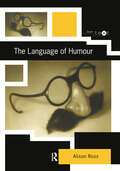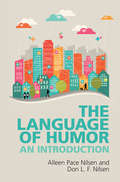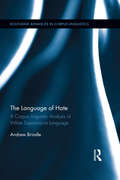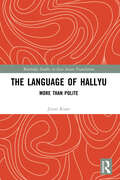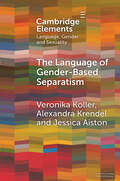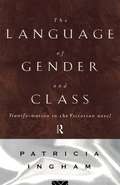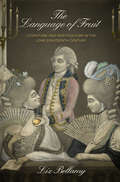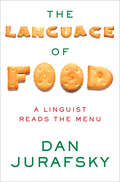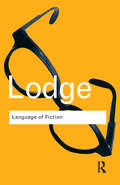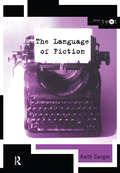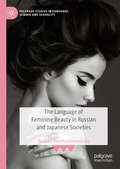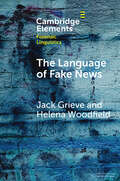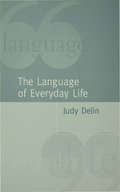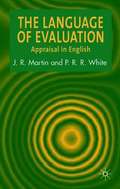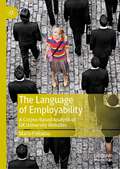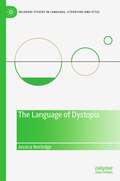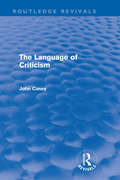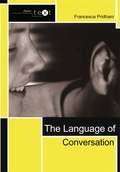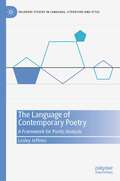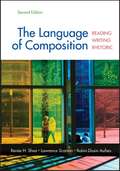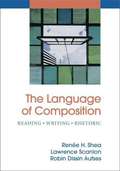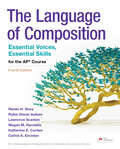- Table View
- List View
The Language of Humour (Intertext)
by Alison RossThe Language of Humour:* examines the importance of the social context for humour* explores the issue of gender and humour in areas such as the New Lad culture in comedy and stand-up comedy* includes comic transcripts from TV sketches such as Clive Anderson and Peter Cook
The Language of Humor: An Introduction
by Don L. Nilsen Alleen Pace NilsenMuch of today's communication is carried out through various kinds of humor, and we therefore need to be able to understand its many aspects. Here, two of the world's leading pioneers in humor studies, Alleen and Don Nilsen, explore how humor can be explained across the numerous sub-disciplines of linguistics. Drawing on examples from language play and jokes in a range of real-life contexts, such as art, business, marketing, comedy, creative writing, science, journalism and politics, the authors use their own theory of 'Features, functions and subjects of Humor' to analyze humor across all disciplines. Each highly accessible chapter uses a rich array of examples to stimulate discussion and interaction even in large classes. Supplemental PowerPoints to accompany each of the 25 chapters are available online, taking many of the insights from the chapters for further interactional discussions with students.
The Language of Hate: A Corpus Linguistic Analysis of White Supremacist Language (Routledge Advances in Corpus Linguistics)
by Andrew BrindleIn this book, Andrew Brindle analyzes a corpus of texts taken from a white supremacist web forum which refer to the subject of homosexuality, drawing conclusions about the discourses of extremism and the dissemination of far-right hate speech online. The website from which Brindle’s corpus is drawn, Stormfront, has been described as the most powerful active influence in the White Nationalist movement (Kim 2005). Through a linguistic analysis of the data combining corpus linguistic methodologies and a critical discourse analysis approach, Brindle examines the language used to construct heterosexual, white masculinities, as well as posters’ representations of gay men, racial minorities and other out-groups, and how such groups are associated by the in-group. Brindle applies three types of analysis to the corpus: a corpus-driven approach centered on the study of frequency, keywords, collocation and concordance analyses; a detailed qualitative study of posts from the forum and the threads in which they are located; and a corpus-based approach which combines the corpus linguistic and qualitative analyses. The analysis of the data demonstrates a convergence of reactionary responses to not only women, gay men and lesbians, but also to racial minorities. Brindle’s findings suggest that due to the forum format of the data, topics are discussed and negotiated rather than dictated unilaterally as would be the case in a hierarchical organization. This research-based study of white supremacist discourse on the Internet facilitates understanding of hate speech and the behavior of extremist groups, with the aim of providing tools to combat elements of extremism and intolerance in society.
The Language of Hallyu: More than Polite
by Jieun KiaerThe Language of Hallyu will re-examine the language of the Korean Wave by looking at popular K-content. In doing so, it will expose the meanings that get lost in translation, hidden under subtitles. Over the past decade, hallyu (the Korean wave) has exploded in popularity around the globe. K-films, K-drama, and K-pop were once small subcultures, known mostly by Korea’s East and Southeast Asian neighbours and Korean diaspora. Now, K-content has entered the international mainstream. Consequently, interest in Korean language has grown, while interest in language learning in general has decreased. Many textbooks emphasise that Korean is a ‘polite’ language, but this book will highlight that this is not the case. The Language of Hallyu examines popular K-content, including Parasite (2019), Minari (2020), Squid Game (2021), and Pachinko (2022). The author introduces language stylistics to explain how Koreans style their language to suit every occasion. She argues that they do this via a process of visual scanning and social tuning, whereby visual clues are assessed in tangent with an individual’s sociocultural awareness. The author concludes by highlighting the danger of the jondaemal/banmal (polite/casual speech) divide, demonstrating that Korean language is so much more than polite. This book will be of interest to students and researchers in Korean language and culture, particularly those interested in linguistics and pragmatics.
The Language of Gender-Based Separatism: A Comparative Analysis (Elements in Language, Gender and Sexuality)
by Veronika Koller Alexandra Krendel Jessica AistonThis Element shows how two social movements, lesbian separatism and Men Going Their Own Way (MGTOW), reflect the changing and complex (anti-)feminist ideologies of their time. The authors outline the historical and political background of those discourses and how they are influencing contemporary gender relations. The materials analysed comprise ten manifestos, which are examined with a combination of data-led discourse analysis and theory-led argumentation analysis. The manifestos are similar in that both sets of authors construct homogenous in-groups and out-groups as well as dichotomies between them. There are some differences though in how this is linguistically realised and who is classified as an out-group. Both groups cast social actors in particular roles and establish ethical norms, but strategic planning and utopias are more prominent among lesbian separatists. Freedom, advantage and authority are central in each group's argumentation, but lesbian separatists also stress humanitarianism while MGTOW focus on financial matters.
Language of Gender and Class: Transformation in the Victorian Novel
by Patricia InghamThe Language of Gender and Class challenges widely-held assumptions about the study of the Victorian novel. Lucid, multilayered and cogently argued, this volume will provoke debate and encourage students and scholars to rethink their views on ninteenth-century literature. Examining six novels, Patricia Ingham demonstrates that none of the writers, male or female, easily accept stereotypes of gender and class. The classic figures of Angel and Whore are reassessed and modified. And the result, argues Ingham, is that the treatment of gender by the late nineteenth century is released from its task of containing neutralising class conflict. New accounts of feminity can begin to emerge. The novels which Ingham studies are: * Shirley by Charlotter Bronte * North and South by Elizabeth Gaskell * Felix Holt by George Eliot * Hard Times by Charles Dickens * The Unclassed by George Gissing * Jude the Obscure by Thomas Hardy
The Language of Fruit: Literature and Horticulture in the Long Eighteenth Century (Penn Studies in Landscape Architecture)
by Liz BellamyIn The Language of Fruit, Liz Bellamy explores how poets, playwrights, and novelists from the Restoration to the Romantic era represented fruit and fruit trees in a period that saw significant changes in cultivation techniques, the expansion of the range of available fruit varieties, and the transformation of the mechanisms for their exchange and distribution. Although her principal concern is with the representation of fruit within literary texts and genres, she nevertheless grounds her analysis in the consideration of what actually happened in the gardens and orchards of the past.As Bellamy progresses through sections devoted to specific literary genres, three central "characters" come to the fore: the apple, long a symbol of natural abundance, simplicity, and English integrity; the orange, associated with trade and exchange until its "naturalization" as a British resident; and the pineapple, often figured as a cossetted and exotic child of indulgence epitomizing extravagant luxury. She demonstrates how the portrayal of fruits within literary texts was complicated by symbolic associations derived from biblical and classical traditions, often identifying fruit with female temptation and sexual desire. Looking at seventeenth-century poetry, Restoration drama, eighteenth-century georgic, and the Romantic novel, as well as practical writings on fruit production and husbandry, Bellamy shows the ways in which the meanings and inflections that accumulated around different kinds of fruit related to contemporary concepts of gender, class, and race.Examining the intersection of literary tradition and horticultural innovation, The Language of Fruit traces how writers from Andrew Marvell to Jane Austen responded to the challenges posed by the evolving social, economic, and symbolic functions of fruit over the long eighteenth century.
The Language of Food: A Linguist Reads the Menu
by Dan Jurafsky2015 James Beard Award Nominee: Writing and Literature category Stanford University linguist and MacArthur Fellow Dan Jurafsky dives into the hidden history of food. Why do we eat toast for breakfast, and then toast to good health at dinner? What does the turkey we eat on Thanksgiving have to do with the country on the eastern Mediterranean? Can you figure out how much your dinner will cost by counting the words on the menu? In The Language of Food, Stanford University professor and MacArthur Fellow Dan Jurafsky peels away the mysteries from the foods we think we know. Thirteen chapters evoke the joy and discovery of reading a menu dotted with the sharp-eyed annotations of a linguist. Jurafsky points out the subtle meanings hidden in filler words like "rich" and "crispy," zeroes in on the metaphors and storytelling tropes we rely on in restaurant reviews, and charts a microuniverse of marketing language on the back of a bag of potato chips. The fascinating journey through The Language of Food uncovers a global atlas of culinary influences. With Jurafsky's insight, words like ketchup, macaron, and even salad become living fossils that contain the patterns of early global exploration that predate our modern fusion-filled world. From ancient recipes preserved in Sumerian song lyrics to colonial shipping routes that first connected East and West, Jurafsky paints a vibrant portrait of how our foods developed. A surprising history of culinary exchange--a sharing of ideas and culture as much as ingredients and flavors--lies just beneath the surface of our daily snacks, soups, and suppers. Engaging and informed, Jurafsky's unique study illuminates an extraordinary network of language, history, and food. The menu is yours to enjoy.
The Language of Fiction: Essays in Criticism and Verbal Analysis of the English Novel (Classics Ser.)
by David LodgeLanguage of Fiction was the first book of criticism by the renowned novelist and critic David Lodge. His uniquely informed perspective - he was already the author of three successful novels at the time of its first publication in 1966 - and lucid exposition meant that the work proved a landmark of literary criticism, not least because it succeeded in communicating a radically new vision of English literature to a readership that reached well beyond the bounds of the academy. Now reissued with a new foreword, this major work from the pen of one of England's finest living writers is essential reading for all those who care about the creation and appreciation of literature.
The Language of Fiction (Intertext Ser.)
by Keith SangerWhat makes literature? How does it work? How do we read it? This work explores these questions and varying literary styles and authorship. It deals with openings, point of view, speech, gender and pop fiction. The book includes a wide-range of literary extracts, from the classics of Hardy and Austen, to the contemporary work of Raymond Carver, Angela Carter, Nick Hornby and Irvine Welsh.
The Language of Feminine Beauty in Russian and Japanese Societies (Palgrave Studies in Language, Gender and Sexuality)
by Natalia KonstantinovskaiaThis book conducts a cross-linguistic and cross-cultural study of 'women’s language' as it pertains to feminine beauty. It examines the ideological constructs of beauty and femininity in the cultures of Japan and Russia, as embodied through televised beauty ads, and relates them to the real-world language practices of Japanese and Russian women. The author traces the reciprocal connection between women’s real and imagined language in the construction of ideals of beauty and femininity, revealing the complex ways women respond to ideological expectations regarding language use: assimilating, transforming, and subverting ideologized language and the assumptions implicit in it. She also demonstrates ways in which women alter the texture of language by appropriating 'masculine' language for their own purposes, shifting the meaning and correlates of linguistic items and structures. This book will be of interest to students and scholars of sociolinguistics, language and gender, cultural and media studies, and Russian and Japanese culture.
The Language of Fake News (Elements in Forensic Linguistics)
by Jack Grieve Helena WoodfieldIn this Element, the authors introduce and apply a framework for the linguistic analysis of fake news. They define fake news as news that is meant to deceive as opposed to inform and argue that there should be systematic differences between real and fake news that reflect this basic difference in communicative purpose. The authors consider one famous case of fake news involving Jayson Blair of The New York Times, which provides them with the opportunity to conduct a controlled study of the effect of deception on the language of a single reporter following this framework. Through a detailed grammatical analysis of a corpus of Blair's real and fake articles, this Element demonstrates that there are clear differences in his writing style, with his real news exhibiting greater information density and conviction than his fake news. This title is also available as Open Access on Cambridge Core.
The Language of Everyday Life: An Introduction
by Judy DelinThis is a lively, practical guide that provides a fascinating linguistic description of six familiar text and discourse types, showing how language works in everyday life to perform its particular purpose. Through original examples, students are introduced to a wide-ranging repertoire of analytical concepts and techniques, described in basic, clear terms, and drawn from a broad range of areas of linguistics and language study. The aim of the book is to enable students to discover for themselves what is interesting about different language situations, and to begin to interrogate the relationship between language, society, and ideology. The Language of Everyday Life includes: topics for discussion; exercises, and; further readings; extensive glossary of technical terms; a practical guide to project work.
Language of Evaluation: Appraisal in English
by J. R. Martin P. WhiteThe impetus for this book grew out of work on narrative genres, principally undertaken by Guenter Plum and Joan Rothery at the University of Sydney through the 1980s. Their point was that interpersonal meaning was critical both to the point of these genres (as emphasised by Labov) and also to how we classified them. This encouraged us to extend the model of interpersonal meaning that we had available at the time (based largely on work by Cate Poynton on language and gender), especially in the direction of one that could handle affect alongside modality and mood.
The Language of Employability: A Corpus-Based Analysis of UK University Websites
by Maria FotiadouThis book employs a corpus-based Critical Discourse Analysis (CDA) methodology to analyse the language used by university careers services in the UK. Drawing on a corpus which includes the public-facing websites of careers services from 24 Russell Group and 34 Post-92 universities, the author highlights some of the potentially problematic 'common-sense' views and ideas that are currently promoted to students using these services. She argues that the language used by university websites promotes neoliberal ideology and encourages the denaturalisation of such language. This book will be of interest to linguists, sociologists, education scholars, and scholars who are otherwise interested in the notion of employability.
The Language of Dystopia (Palgrave Studies in Language, Literature and Style)
by Jessica NorledgeThis book presents an extended account of the language of dystopia, exploring the creativity and style of dystopian narratives and mapping the development of the genre from its early origins through to contemporary practice. Drawing upon stylistic, cognitive-poetic and narratological approaches, the work proposes a stylistic profile of dystopia, arguing for a reader-led discussion of genre that takes into account reader subjectivity and personal conceptualisations of prototypicality. In examining and identifying those aspects of language that characterise dystopian narratives and the experience of reading dystopian fictions, the work discusses in particular the manipulation and construction of dystopian languages, the conceptualisation of dystopian worlds, the reading of dystopian minds, the projection of dystopian ethics, the unreliability of dystopian refraction, and the evolution and hybridity of the dystopian genre.
The Language of Criticism (Routledge Revivals)
by John CaseyFirst published in 1966, the Language of Criticism was the first systematic attempt to understand literary criticism through the methods of linguistic philosophy and the later work of Wittgenstein. Literary critical and aesthetic judgements are rational, but are not to be explained by scientific methods. Criticism discovers reasons for a response, rather than causes, and is a rational procedure, rather than the expression of simply subjective taste, or of ideology, or of the power relations of society. The book aims at a philosophical justification of the tradition of practical criticism that runs from Matthew Arnold, through T.S.Eliot to I.A.Richards, William Empson, F.R.Leavis and the American New Critics. It argues that the close reading of texts moves justifiably from text to world, from aesthetic to ethical valuation. In this it differs radically from the schools of "theory" that have recently dominated the humanities.
The Language of Conversation (Intertext)
by Francesca PridhamThis accessible satellite textbook in the Routledge Intertext series offers students hands-on practical experience of textual analysis of conversation. Written in a clear, user-friendly style by an experienced teacher, it combines practical activities with texts, accompanied by commentaries and suggestions for further study. It can be used individually or in conjunction with the series core textbook Working With Texts Aimed at A-Level and beginning undergraduate students, The Language of Conversation:* Analyses exactly what happens during conversation and why* Discusses the structure, purpose, and features of conversation* Explores the relationship between speaker and listener* Examines different kinds of conversation, such as chatroom conversations, extracts from chatshows and everyday conversation* Provides a clear introduction to technical terms.
The Language of Contention
by Sidney TarrowThis book examines the relations between the material and political bases of contentious politics and the construction, diffusion and endurance of contentious language. Beginning with the language of revolution developed from the seventeenth to the nineteenth centuries, it examines contentious language at work, in gender and race relations and in nationalist and ethnic movements. It closes with an examination of emotions in contentious politics, reflecting on the changes in political language since 9/11 and assessing the impact of religion and recent innovations in electronic communication on the language of politics.
The Language of Contemporary Poetry: A Framework for Poetic Analysis (Palgrave Studies in Language, Literature and Style)
by Lesley JeffriesThis book introduces a new way of looking at how poems mean, drawing on the framework first developed in the author’s book Critical Stylistics, but applied here to aesthetic more than ideological meaning. The aim is to empower readers of poetry to articulate the features of poetic language that they come across and explain to themselves and others why these features convey the meanings that they do. While this volume focuses on contemporary poets writing in English and mostly based in the UK and Ireland, the framework will work just as well for other eras’ poetry, as well as for other cultures and languages.
The Language Of Composition: Reading, Writing, Rhetoric
by Lawrence Scanlon Robin Aufses Renee SheaThe Language of Composition is the first textbook built from the ground up to help students succeed in the AP English Language course. Written by a team of experts with experience in both high school and college, this text focuses on teaching students the skills they need to read, write, and think at the college level. With practical advice and an extensive selection of readings -- including essays, poetry, fiction, and visual texts --The Language of Composition helps students develop the key skills they must master to pass the course, to succeed on the AP Exam, and to prepare for a successful college career. Revised based on feedback from teachers across the country, the second edition promises to be an even better resource for the AP Language classroom.
The Language of Composition: Reading, Writing, Rhetoric
by Renée H. Shea Lawrence Scanlon Robin Dissin AufsesThe Language of Composition is the first college-level textbook created specifically for the AP* English Language course. Inside, students will find everything they need to learn college-level reading, writing, and analysis skills: concise introductory chapters on rhetoric, close reading, and synthesizing sources; a rich collection of thematically arranged readings that includes essays, speeches, letters, newspaper columns, as well as fiction, poetry, and visual texts; carefully crafted assignments that reinforce the skills taught in the introductory chapters; and much more. The Language of Composition - designed to help students succeed in the AP English Language course and embark on a successful college career. Book jacket.
The Language of Composition: Reading, Writing, Rhetoric
by Renée H. Shea Lawrence Scanlon Robin Dissin AufsesNIMAC-sourced textbook
The Language of Composition: Reading, Writing, Rhetoric
by Renee H. Shea Lawrence Scanlon Robin Dissin AufsesThe ideal book for the AP English Language course. The Language of Composition is the first textbook built from the ground up to help students succeed in the new AP English Language course. Written by a team of experts with experience in both high school and college, this text focuses on teaching students the skills they need to read, write, and think at the college level. With practical advice on reading and writing and an extensive selection of readings#xA0;-- including essays, poetry, fiction, and visual texts that are both interesting and appropriate for a high school audience --The Language of Composition helps students develop the key skills they must master to pass the course, to succeed on the AP Exam, and to prepare for a successful college career.
The Language of Composition: Essential Voices, Essential Skills for the AP® Course
by Renee H. Shea Lawrence Scanlon Robin Dissin Aufses Megan M. Harowitz Katherine E. Cordes Carlos EscobarEverything You Need to Succeed in AP® Language.Give yourself the best foundation to earn a great score.The Language of Composition includes all of the skills instruction, practice, readings, and AP® tips you need to be successful on the AP® Language and Composition Exam.
